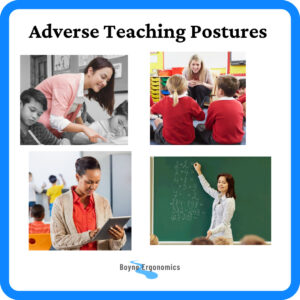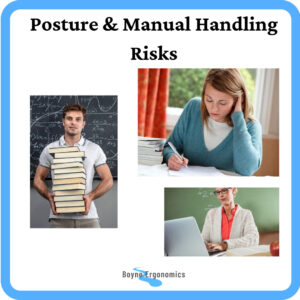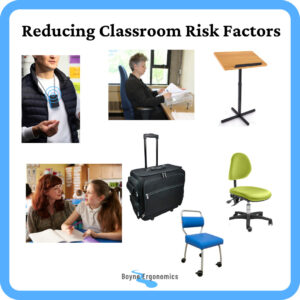In the last post, I outlined what we as carer’s should be aware of to ensure healthy ergonomic practices and musculoskeletal development in children and adolescents, but what about the educators?
Teaching is a physically and cognitively demanding job. Teacher health and quality of life has been found to be influenced by working conditions, musculoskeletal comfort and psychological wellbeing.
By creating awareness of the risks of injury and educating the educators on how to reduce that risk, we ensure that the people teaching our children can do so without excessive pain and discomfort.
Kraemer et al (2020) reported that musculoskeletal disorders have been identified as one of the main causes of illness and disability among teachers, along with psychological and behavioural conditions and respiratory conditions. They found that teachers were reporting symptoms of low back pain, shoulder pain and neck pain associated with workplace tasks.
Voice injury is another reported issue among teachers. Byeon (2019) reported in their analysis that the rates of voice injury among teachers ranges from 10 – 70%, with reported symptoms including sore throat, vocal fatigue and hoarseness, with vocal nodules in more extreme cases.
What Are The Risks Associated With Teaching?
Teaching different age groups and ability groups can present different challenges and risks for teachers.
- Repetitive Adverse Postures
Repetitive adverse postures often occur in the classroom when bending down to check on student’s at their desks and when writing on or cleaning boards.
Many teachers also hang artwork around the classroom and this can involve a lot of reaching over shoulder height.
- Prolonged Static Postures
Teachers are exposed to the risk of prolonged static postures, either sitting or standing, when preparing classwork, correcting classwork, prolonged computer device use and supervision duties.
- Repetitive Movements
Repetitive movements are often present when correcting classwork or exams, writing on and cleaning boards and during computer device use.

- Adverse DSE Related Postures
Many classrooms have laptops, desktop computers or tablets for use by teachers and students alike, but are not always equipped with the appropriate peripheral equipment or are not set up correctly for the user.
- Contact Stress
Contact stress in the classroom can occur cumulatively due to adverse postures or as an acute injury e.g catching thigh off corner of a desk.
- Manual Handling
Manual handling is a part of classroom management. Whether it is lifting and transporting work to be corrected, boxes of toys, boxes of arts and crafts supplies or moving classroom furniture around, the risk of manual handling related injury is a factor to be considered.
- Psychosocial Risk Factors
Ng et al (2019) cited depression and psychosocial risk factors as predictors for musculoskeletal discomfort among teachers. These factors can include, but are not limited to perceived work demands, high cognitive demand, perceived control over role and tasks, support from colleagues and support staff, emotional demands and integration or personal and work life.
- Voice Strain
Excessive use of voice, high voice volume, dehydration, adverse postures and poor ventilation can contribute to the risk of voice injury.
- Physical Injury From Student
This is a risk in a classroom where there are students with behavioural conditions that can tend to strike, run, grab or hit others.

How Can Teachers Reduce The Risk of Classroom Related Injuries?
- Reduce Repetitive Adverse Postures
When reviewing student work, be sure to bend the knees and lower your body to the side of the student.
Use a portable stool or pull up a chair to ensure a stable base when talking to students at their level. There a a number of classroom seating options designed to encourage supported seated postures for teachers when interacting with students, such as the JollyBack Chair and the Luna Kindergarden Chair.
Avoid overreaching and writing above shoulder level when writing on and cleaning the board. Some classrooms are equipped with sliding or rolling boards, interactive whiteboards, smart boards which can all be used to reduce board related adverse postures. Aim to write between waist and shoulder height.
Use a laser pointer or extendable manual pointer to draw attention to required parts of the board.
Use a step or step ladder when hanging artwork and decorations in the classroom.
- Reduce Prolonged Static Postures
Set up the classroom and lesson plan to allow you to frequently and easily move from seated to standing posture, with regular periods of walking and movement.
A portable lectern can be a useful addition to the classroom to allow the teacher to conduct lessons in the seated or standing postures. Electric sit stand desks could also be useful but not yet a regular feature in our classrooms.
- Reduce Repetitive Movements
When using the mouse and keyboard, ensure that the wrists are straight, with a loose grip on the mouse. Avoid moving the hand side to side when operating the mouse and typing.
When correcting work, take regular breaks, at least once every 30 minutes and alternate hands.
- Reduce Adverse DSE Related Postures
When using computer devices, ensure the screen is level with the eyeline, and that a stand, keyboard and mouse is available to allow for appropriate positioning of laptops and tablets.
Height adjustable chairs with adjustable back support and a classroom desk with appropriate leg clearance space will allow for ideal desk positioning.
- Reduce Contact Stress
Ensure you are seated at the appropriate height for the workstations to reduce contact stress on the wrists.
Where possible, ensure the classroom layout allows appropriate spacing between the desks to reduce the risk of coming into contact with them.
- Reduce Manual Handling Risk
Arrange storage to ensure that the heaviest items are between waist and shoulder height, with lighter items above shoulder height.
Ensure appropriate manual handling techniques are used.
Use a wheeled bag for transporting texts and books to and from the classroom.
Ask for help with heavier or awkward items if you do not feel you can safely handle them.
- Reduce Impact of Psychosocial Risk Factors
This can be complex and difficult to get right all the time as demands change, staff change and personal circumstances change. Zirwatul Aida R Ibrahim et al (2021) reported that teacher who experience high social support, with moderate job demands and job control are impacted less by stress and depression. This is a complicated relationship but a good start is ensuring that schools are appropriate staffed for the number of pupils activities and roles, teachers are clear on their roles and support available to them and schools and that senior staff encourage an open and participatory staffroom.
- Reduce The Risk Of Voice Injury
To protect the throat and reduce the risk of a voice injury it is important to stay hydrated, ensure the classroom is well ventilated and take regular breaks from talking.
Voice amplifiers can be useful to increase the volume and carry of the voice without straining the throat.
Ensure appropriate postures, think ear over shoulder, when speaking in class.
- Reduce Risk of Physical Injury From Student
Take the time to get to know your students, any potential behavioural issues and triggers and your surroundings.
When possible, do not turn your back on your students, especially those with known tendencies to physically express their emotions.

There are ergonomic adaptations and adjustments that can help reduce musculoskeletal discomfort and injury in the classroom. Early intervention is important to ensure mild discomfort does not become a chronic or debilitating condition.
Sources
Kraemer et al (2020), Musculoskeletal pain and ergonomic risks in teachers of a federal institution. https://www.ncbi.nlm.nih.gov/pmc/articles/PMC7879465/
Byeon, H. (2019), The risk factors related to voice disorder in teachers: A systematic review and meta-analysis. https://www.ncbi.nlm.nih.gov/pmc/articles/PMC6801660/


